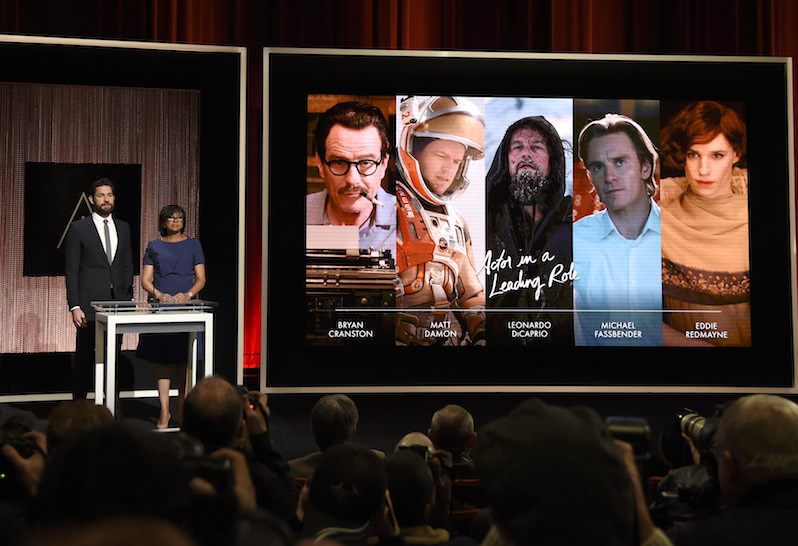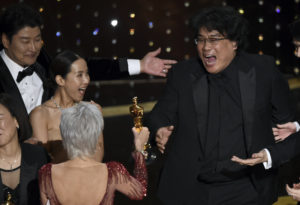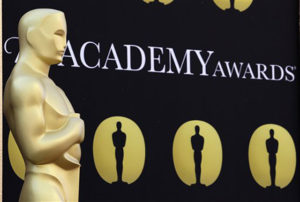To Make the Oscars More Diverse, Let’s Adopt Football’s Rooney Rule
Voluntary steps to include more people of color and women should be a priority throughout the entire Hollywood system of moviemaking, from studios’ executive ranks to casting. Chris Pizzello / Invision / AP, File
Chris Pizzello / Invision / AP, File
When Oscar nominations were announced Jan. 14, the vast majority of Academy members and all 20 acting contenders were white, and the Oscar race became about race. By Jan. 18, Martin Luther King Day, actress Jada Pinkett Smith and filmmaker Spike Lee had sent their regrets via social media that they would not be attending this year’s Academy Awards ceremonies.
Given the Academy voter demographics — those of color make up just 7 percent of the group — the suspicion is that the organization is snow-blind, its members seeing only white. That the nominations for the black-themed films “Straight Outta Compton” and “Creed” went, respectively, to white screenwriters and a white actor further confirmed it. “For African-American artists and moviegoers, the situation is reminiscent of what Ralph Ellison wrote about being black in America in ‘Invisible Man,’ ” observed Kareem Abdul-Jabbar in an article published Wednesday. “The Academy members watched ‘Creed,’ written by two black men (Ryan Coogler, Aaron Covington), directed by a black man (Coogler), starring a black man (Michael B. Jordan) and with mostly a black cast, yet the only person they saw was Sylvester Stallone.” Not only is the Academy too pale, say protesters, it is also too male: About 76 percent of its members are men.
Fortunately, institutional response was swift. On Jan. 21, Academy President Cheryl Boone Isaacs (who is African-American) announced the acceleration of changes to improve diversity that were already underway. She said the Academy was on track to double membership of nonwhites to 14 percent and increase female members to 48 percent by 2020. Problem solved?
A good start. But only part of the whole solution.
That’s because the problem is not just the Academy, which became a lightning rod for what its CEO Dawn Hudson calls the “conversation … happening in corporate America … in our police departments [and] with our politicians.” The problem is that after nearly a century, Hollywood — like the rest of corporate America — continues to be the stronghold of (almost exclusively white) men who decide what gets made, who gets cast and what gets promoted for Academy Awards.
The process goes something like this: Studios decide what gets greenlighted., the overwhelming majority of which are stories of (white) men overcoming adversity. (See this year’s best picture nominees “Bridge of Spies,” “The Big Short,” “The Martian,” “The Revenant” and “Spotlight”). Accordingly, these scripts are (mostly) cast with white men. People of color and women can’t get nominated for movies and roles that aren’t there, to paraphrase what Viola Davis said when she accepted an Emmy last year.
You might argue that there were prominent movies about black men in 2015, citing “Beasts of No Nation,” “Concussion,” “Creed” and “Straight Outta Compton.” Yes, but these films did not have major studio Oscar campaigns behind them. That they did not is most likely the result of an institutional belief that an Oscar movie is a drama of a white man overcoming some difficulty (e.g., “Chariots of Fire,” “Rain Man,” “The King’s Speech”). An Oscar film is only rarely a comedy or a genre movie, the types of pictures historically offering opportunities for nonwhite and female filmmakers and actors.
How can the industry take this vicious cycle and transform it into a virtuous one?
In his regrets to the Academy, Spike Lee suggested that the studios adopt a version of the NFL’s Rooney Rule, which obliges executives to interview minority candidates for senior positions before hiring for that job.
“What can studios do to be more inclusive?” asked an Oscar-nominated writer-director who spoke under the condition of anonymity. “Hiring more women and people of color in the executive ranks is a start. They would bring in a different kind of talent into the system.”
Actor Idris Elba, whose performance in “Beasts of No Nation” was overlooked by the Academy this year, delivered a rousing speech to the British Parliament last week, talking about the importance of colorblind casting. Though Matt Damon played the part of the stranded astronaut in “The Martian,” the role could have been cast with Will Smith or Elba himself. (Or with Sandra Bullock, whose role as the stranded astronaut in 2013’s “Gravity” was written for a man.)
Voluntary steps (the Rooney Rule, colorblind casting) are ways for studios to be proactive about inclusion. They would not be punitive, as are mandates or quotas.
Currently the Equal Employment Opportunity Commission is hearing testimony on the underemployment of female filmmakers. There are many who hope the EEOC will mandate a quota for the number of women hired as directors. But if a quota is imposed on the studios, might those hired feel like tokens? True affirmative action is action that is affirmative rather than imposed.
I fervently hope that Hollywood’s other institutions will follow the Academy’s lead — and speed — in implementing inclusionary measures. And if any readers have other ideas about achieving this, I’d like to hear them.
Your support matters…Independent journalism is under threat and overshadowed by heavily funded mainstream media.
You can help level the playing field. Become a member.
Your tax-deductible contribution keeps us digging beneath the headlines to give you thought-provoking, investigative reporting and analysis that unearths what's really happening- without compromise.
Give today to support our courageous, independent journalists.






You need to be a supporter to comment.
There are currently no responses to this article.
Be the first to respond.